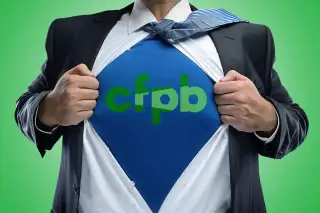The CFPB Turns 5 Today. Here's What It's Done (and What It Hasn't)

The Consumer Financial Protection Bureau turns five today.
The agency, created in the wake of the financial crisis, was supposed to protect American consumers from the abuses of the financial industry after millions got burned by ill-advised mortgages. The idea—formulated by Elizabeth Warren, then an influential law professor, now a Massachusetts senator—was supposed to be simple: A new bureau to vet financial products the same way the Consumer Product Safety Commission vets toasters.
Ultimately created as part of the 2010 Dodd-Frank financial reform act, the CFPB inherited a sprawling mandate, giving it authority over areas of American financial lives ranging from mortgages to credit cards to debt collection. It's also inspired controversy, with critics arguing from the start the agency represented a new era in government overreach. Now five years on, here is what the CFPB has accomplished...and what it hasn't.
1. Staying alive
The CFPB faced opposition from the start from fearful businesses and libertarians worried about the nanny state. One high-ranking Chamber of Commerce official reportedly promised to "spend whatever it takes" to derail the new agency. Opponents scored an early victory in 2011, when President Obama nominated former Ohio Attorney General Richard Cordray, rather than Warren, as its first director. Since then the CFPB has had its share of growing pains, including staffing problems. But thanks in part to Obama's re-election, it has resisted Republican calls to abolish it or otherwise curtail its power.
Is it out of the woods? Not necessarily. Come November, the Republicans could finally find themselves in charge of both Congress and the White House. But it may be that the worst is over. The party's 2016 convention platform condemns the bureau as "the worst of Dodd Frank" but then seems to implicitly acknowledge that the CFPB is here to stay. "If the Bureau is not abolished," it continues, then calls for more modest goal of making its funding subject to Congressional approval.
2. Mortgage rules
The financial crisis partly resulted from a breakdown of traditional mortgage lending standards, so creating new rules for the industry has been one of the CFPB's highest-profile priorities. The Bureau has accomplished two big changes. In 2013, it set new standards for the mortgage market, requiring most lenders to verify borrowers' income and ability to repay loans and discouraging many types of exotic mortgages—such ones boasting introductory "teaser" interest rates—that led to some of the worst abuses of the financial crisis. And in October 2015, the Bureau tackled another thorny area: Simplifying the disclosures that borrowers receive when they take out a loan.
While the new disclosures should ultimately make it easier for consumers to compare mortgage terms, some critics have argued the Bureau's earlier effort to toughen lending standards was too timid. One big reason: To avoid making it too hard for younger and less wealthy borrowers to buy homes (and angering its Democratic allies in Congress), the CFBP declined to set minimum credit scores or require borrowers to have hefty down payments. As a result, far more risk has seeped into the new, supposedly reformed mortgage market than many would like to see.
3. Enforcement
In addition to writing new rules, the CFPB also has the authority to enforce those that are already on the books. It hasn't been shy. By its own tally, the agency has realized more than $11.7 billion in "relief," meaning penalties and other items like forgiven debt balances, passing the benefits on to more than 27 million consumers.
These haven't been one-offs against small time bad actors, either. Last year the Bureau forced Citibank to offer $700 million in compensation to customers after accusing it of misleading consumers into buying unwanted credit card "add-ons," such as identity-theft protection. In 2014, it wrung more than $720 million out of Bank of America for similar violations. The Bureau has also levied big penalties against lesser-known companies that are nonetheless leading players in industries that have attracted controversy for the way they've treated individual consumers, such mortgage servicing, debt collection, and payday lending.
Of course, like all aspects of the CFPB, this hasn't come without criticism. Some have argued (registration required) that the agency's big enforcement actions amount to a bureaucratic end-run around the formal rule-making process—in effect, an unauthorized extension of the agency's reach that can't be fought via the usual political channels.
4. Unfinished business
Despite the CFPB's accomplishments with mortgages, rules for a number of other industries are still sitting on the drawing board. Among areas that it has targeted—but not yet affected change—are abusive lending practices by payday lenders and arbitration clauses in consumer contracts that make it difficult for borrowers and credit-card customers to take part in class-action lawsuits. Also on the agency's current agenda is a new proposal to further limit bank overdraft fees, which suck as much as $30 billion out of bank customers' pockets each year.
Read Next: How Companies Block Your Day in Court
Of course, five years seems like a long time to get rules off the ground. After all, U.S. presidents serve only four and House members two. But given the slow pace at which financial regulations move through Washington, five years isn't an extraordinarily long time. The fiduciary rule, a parallel effort to protect investors by the SEC and Labor Department, was on the drawing board for roughly a decade in various forms before being finalized this spring.
All the same, even at its fifth birthday, the CFPB still has some of its most important work cut out for it.